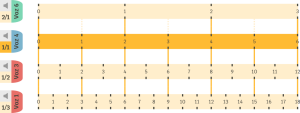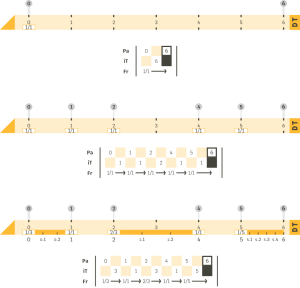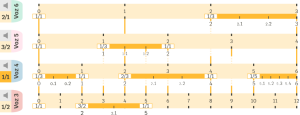Where to apply temporal fractions
Where to apply fractions?
Depending on where we apply the fractions we will generate different effects, expanding our creative possibilities.
In a musical idea we can apply anytype of fraction. Some fractions change the velocity in a fixed manner throughout the voice (example 1)others punctually within a segment of the voice (example 2)and we can even combine the two ways (example 3).

When we apply a fraction We do this from the beginning to the end of a voice, establishing a new pulsation continuously. For a fraction to be applicable, there must be a specific relationship between the total length of the voice and the fraction we choose: the numerator of the fraction must be divisor of the original length.
In our example with original length 6 (fraction 1/1), its divisors are 1, 2, 3 and 6, so we can apply any fraction that has one of these divisors in the numerator.

When we apply a simple fraction with 1 in the numerator, we are dividing the original pulsations. We call this process subdivision (example: Voice 3, 1).
When we apply a simple fraction with 1 in the denominator, we are grouping the original pulsations. We call this process grouping (example: Voice 6).

When we apply a complex fraction we call the new pulses a neopulsation to differentiate them from the original ones.

If we apply other punctual fractions to the continuous fractionation (by modifying the fraction line inside the box), we generate fractions of fractions, which we call combined fractions.
The pulsations of the voices to which we apply fractions are related cyclicallycoinciding every so often.
We can apply fractions to any section of the voice, varying the original pulsation and generating a new numbering.
![]()
In order to define the location of this punctual fraction we need to choose the two pulses among those to which it applies. We call these pulses structural pulses of the fractionation. In the following example, we delimit the different fractions through pulses 1, 2, 4 and 5, in addition to the first and last pulse of the segment, which always act as structural pulses.
We apply the fraction 1/3 between pulse 0 and pulse 1; the fraction 2/3 between pulse 2 and pulse 4; and the fraction 1/5 between pulse 5 and pulse 6. The parts of the segment where we do not apply fractionation are kept at 1/1 by default.

If we have several overlapping voices, we can apply a fraction to each voice continuously, generating a velocity different from the original velocity. We can then apply punctual fractions to specific parts of the voices, momentarily varying the original pulsation and modifying the numbering.


